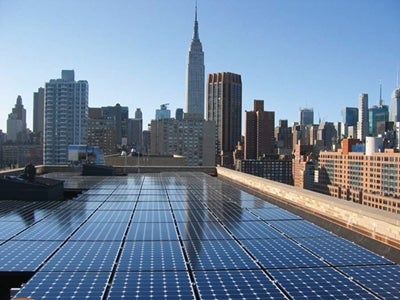By: Susan Leeds, CEO of the New York City Energy Efficiency Corporation (NYCEEC)
As New York City gets repeatedly hammered by snow, ice and the evil “wintry mix,” one could almost forget the world is warming at an ever faster clip. But the experts in the room earlier this month at the roundtable discussion on ‘Economics of Energy Retrofits’ at Urban Green Council (New York’s chapter of the U.S. Green Building Council) know the debate is over. Climate change is real and the window for action is closing. That’s why it’s more important than ever to work toward removing barriers to clean energy financing now.
As the De Blasio administration strives to build a more affordable New York City it’s important to note that clean energy building upgrades are central to this mission. By reducing energy use, building owners and their tenants can realize millions of dollars in annual savings while slashing dangerous carbon pollution for cleaner air and water.
Upfront Cost of Retrofits Presents Obstacle
The market barriers to implementing commonsense energy efficiency upgrades that pay for themselves in just a few years are plain. No one wants to dish out a dollar today for a dollar tomorrow. Upfront costs are a roadblock, no matter how short the payback period. Even when building owners decide to do the right thing, conventional lenders are not focusing on energy efficiency as a valuable service to their clients. This leaves building owners without easy access to clean energy financing.
Sometimes the barriers are even more basic. Despite years of wonk talk about energy efficiency as “low-hanging fruit,” building owners, contractors, and project developers are still in the dark about options, benefits, and appropriate partners to help put talk into action.
State and City Green Banks Clear the Way for Clean Energy Financing
New York City and state have been lucky enough to have prescient authorities who are aware of the large role of financing in addressing climate change. New York City Energy Efficiency Corporation (NYCEEC) and the recently-launched New York state green bank are working to become solution centers for clean energy financing in New York City and state respectively. These institutions are able to leverage expertise and financial muscle to transform inefficient buildings into clean, high-performing investments. By offering custom-built financing at attractive terms, building owners will have no more excuses to leave money on the table.
One project that has taken advantage of the city’s new energy finance offerings is Franklin Plaza, a Mitchell-Lama housing co-op in East Harlem. Franklin Plaza recently closed on the first tranche of its $3.8 million loan through the NYC Housing Development Corporation’s (HDC) Program for Energy Retrofit Loans, a program enabled by HDC’s partnership with NYCEEC. The loan for this project will help reduce Franklin Plaza’s energy use by 15%, cut carbon emissions by 30%, and result in energy savings that are equivalent to averting a 10% rent increase. “The development and preservation of affordable housing is the core of our mission at HDC and the salvation of Franklin Plaza epitomizes this work,” said Marc Jahr, former President of HDC.
NYCEEC recently announced $50 million in financing available through a range of products and partnerships, including equipment loans, mortgage lending, credit enhancements and energy services agreements. This new deployment of private capital is a shot in the arm for clean energy financing and supports:
- Energy efficiency improvements, such as smart lighting, heat pumps, energy management systems, boilers, chillers and more.
- Fuel conversions, under the City’s Clean Heat Initiative, from #6 or #4 heating oil to ultra-low sulfur diesel or natural gas
- Combined heat and power systems.
- Clean distributed generation, including solar and other renewable energy sources.
Clean energy building upgrades have an important role to play in the new Mayor’s promise to increase affordable housing in NYC, and innovative financing program’s like those offered through the city and state’s green banks are exactly what New York needs to ensure a greener, cleaner, and more affordable living experience.
Visit www.NYCEEC.com to learn more about how we are remaking New York City buildings for a cleaner, greener, and more affordable tomorrow.











